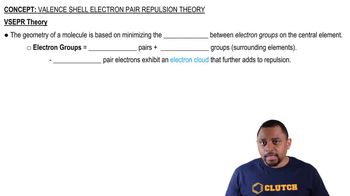Here are the essential concepts you must grasp in order to answer the question correctly.
Hybridization
Hybridization is a concept in chemistry that describes the mixing of atomic orbitals to form new hybrid orbitals. These hybrid orbitals are used to explain the geometry and bonding properties of molecules. For example, in methane (CH4), the carbon atom undergoes sp3 hybridization, resulting in four equivalent sp3 hybrid orbitals that arrange themselves tetrahedrally.
Recommended video:
Molecular Geometry
Molecular geometry refers to the three-dimensional arrangement of atoms within a molecule. The geometry is determined by the number of bonding pairs and lone pairs of electrons around the central atom, which influences the hybridization state. Understanding molecular geometry is crucial for predicting the shape and reactivity of molecules.
Recommended video:
Molecular Geometry with Two Electron Groups
Valence Bond Theory
Valence Bond Theory (VBT) is a fundamental theory that explains how atoms bond by overlapping their atomic orbitals. According to VBT, the formation of a covalent bond occurs when the orbitals of two atoms overlap, allowing for the sharing of electrons. This theory provides the basis for understanding hybridization and the resulting molecular shapes.
Recommended video:
Valence Shell Electron Pair Repulsion Theory




